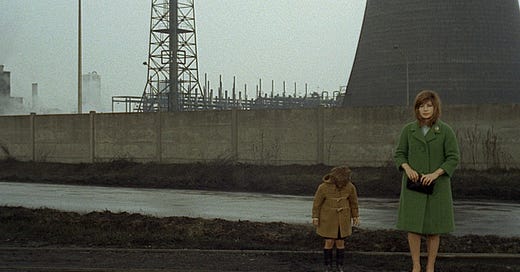Red Desert (1964, Michelangelo Antonioni)
Tuesday the 9th of January 5pm, Richard Hoggart Building cinema
Join us on Tuesday the 9th of January from 5pm (film starts at 5:15pm) for our first screening of term, Michelangelo Antonioni’s classic Red Desert (1964). The film is 1 hour 20 minutes long so the screening will finish around 7:15pm.
Coming mid-way through his Red Desert was Antonioni’s first film in colour, and the Criterion Collection describes it as “perhaps his most epochal”:
This provocative look at the spiritual desolation of the technological age—about a disaffected woman, brilliantly portrayed by Antonioni muse Monica Vitti, wandering through a bleak industrial landscape beset by power plants and environmental toxins, and tentatively flirting with her husband’s coworker, played by Richard Harris—continues to keep viewers spellbound. With one startling, painterly composition after another—of abandoned fishing cottages, electrical towers, looming docked ships—Red Desert creates a nearly apocalyptic image of its time, and confirms Antonioni as cinema’s preeminent poet of the modern age.
See also Mark Le Fanu’s excellent essay for the Criterion release:
Coming after the trilogy of L’avventura (1960), La notte (1961), and L’eclisse (1962), which confirmed his reputation internationally as one of the world’s leading avant-garde directors, Red Desert is the most ambitious of all of Antonioni’s attempts to ground the condition of our modern existence in a theory of alienation. The alienation in question is very complex, and it is part of the film’s difficulty, but also its achievement and seriousness, that the feelings evinced in its dramatization are so fundamentally contradictory and intractable. For on the one hand, Antonioni would say, the world being created by the advance of technology is undoubtedly beautiful: we see it in the fantastic sculptural shapes thrown up by science and industry—the girders and pipings and pylons that are part of a vast new network of global communications, seemingly reaching to the stars (an early sequence in the movie takes us to a deserted rural building site where the University of Bologna is constructing a massive new radio telescope). On the other hand—and here the pounding soundtrack of the film’s opening ten minutes makes its own inescapable comment—this new world is very close to hell. A wasteland is a wasteland, after all, and if a “new beauty” has been born (how powerfully the film shows that it indeed has been), the phenomenon is shot through with poison.
To read more about Antonioni, see the in-depth profile of him from Senses of Cinema.


